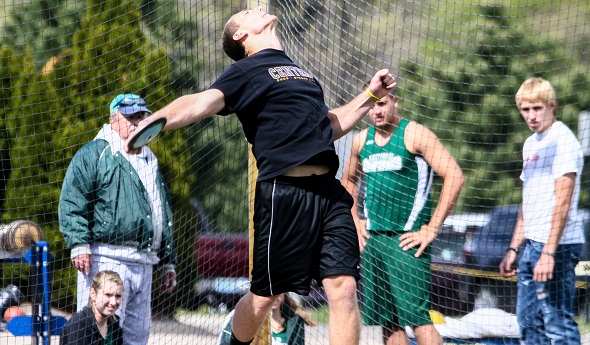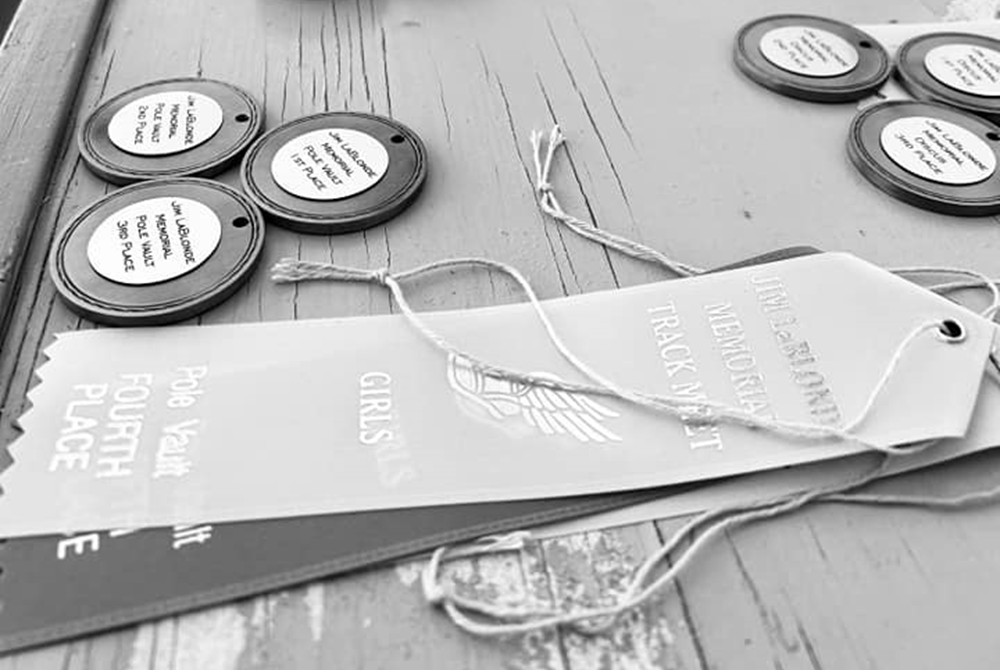
The Throws of a Record-Setting Season
May 3, 2012
By Geoff Kimmerly
Second Half editor
While other kids have basketball hoops in their driveways, Cullen Prena and his sisters have a discus ring.
“I wish,” Cullen said Wednesday when asked if it was so.
You won’t find shot put craters in the family's lawn either.
But drive past the Prenas’ home when his sisters are home from college, and there’s a chance you’ll catch the Walled Lake Central junior and his Big Ten thrower siblings, Kari (University of Michigan) and Kelsey (Michigan State), talking over their craft.
“My sisters got me into it,” Cullen said. “It was a random summer day, and they were going to Central to throw. They asked me if I wanted to go with, and I said ‘Sure.’
“Ever since then I’ve been all into it. It’s basically taken over my life.”
 Those first tosses came in the summer before Prena entered seventh grade. Five years later, he’s making a bid to go down as Michigan’s top high school thrower of all-time.
Those first tosses came in the summer before Prena entered seventh grade. Five years later, he’s making a bid to go down as Michigan’s top high school thrower of all-time.
The fifth-place finisher in discus at last season’s MHSAA Division 1 Final Meet, Prena quickly has established himself as a heavy favorite this spring. He receives a Second Half High 5 this week after throwing an incredible 187 feet, 7 inches to win discus at Saturday’s Oxford Invitational, on top of also winning the shot put with a toss of 52-1.
Earlier in April, Prena topped 180 feet in discus two more times, in the process breaking both his school and then the Oakland County records that had both stood for at least 29 years according to a report by the Oakland Press.
And here’s the kicker: Prena’s top discus throw last season was a solid – but compared to now, mere – 159-9.
“His increase over the course of time, the average spectator can’t see it. But from sixth grade, he’s been training,” said Walled Lake Central boys track coach Nebojsa Stojkovic, who also works with the team’s throwers.
“You know how to gauge kids based on worth ethic and what their bodies are able to do. When freshman year he threw 144 feet, I knew the talent that was coming up.He’s got God-given ability that’s different from everyone else.”
That combination has made Prena something to behold this season.
His work ethic has benefited him with an increase in strength, evidenced by 30-40 percent improvements in all of his weight room lifts over the last year. Prena formerly played football, basketball and baseball, but decided to focus solely on weight training for track this school year in part after tearing a meniscus during his sophomore football season.
And then there’s two natural gifts for a thrower – Prena is double-jointed, allowing him increased flexibility for a stronger whip motion on his discus tosses. He also gets additional power from a wingspan that measures longer than his 6-foot-2 height.
He threw well at indoor competitions during the winter, and was tossing the discus consistently in the 170s when outdoor practice began this spring. In his team’s first meet, against White Lake Lakeland, he threw the discus 177 and then a best of 184-7, and also tossed the shot put 52-10 – more than three feet better than his previous outdoor personal-best in the latter event.
“It was hard to sleep (at night) after a meet when you throw a great throw like that,” Prena said.
Aside from some tires during workouts, Prena hasn’t tried tossing other heavy objects. “Other than my parents and my sisters; that’s about it,” he said, joking, of course.
But he's in serious pursuit of the MHSAA Finals record for discus. Prena’s best toss this season would’ve won every MHSAA Final dating back to 2003 and all seven of last season’s Finals (four Lower Peninsula, three Upper) by at least a foot.
That Finals record of 197-11 belongs to former Portage Northern standout Joey Sarantos, who set it in 2001. Prena must improve another 11 feet – which seems like a logical next step after this spring's gigantic 28-foot jump.
“Last year’s state meet ... didn’t quite go the way I wanted it to, and it’s been in the back of my mind since then,” Prena said. “Coming off of weight training, I kinda expected (the improvement). But you don’t know until you see the stuff. And then I started realizing it, and it was setting in that this is real. This is ridiculous."
PHOTOS: (Top) Walled Lake Central's Cullen Prena warms up before the discus throw that would break the Oakland County record. (Middle) Prena surveys the scene before another discus toss. His best this season is 187-7. (Photos courtesy of Walled Lake Central and David Mexicotte.)

Red Devils Impress as Ironwood Honors Record-Setter with Jim LaBlonde Invitational
By
John Vrancic
Special for MHSAA.com
May 20, 2024
IRONWOOD — The Ironwood track & field teams provided themselves with an opportunity to do a victory lap on a very special Saturday earlier this month.
 Both teams were crowned champions at the first Jim LaBlonde Invitational on May 11 on their 350-meter track during a sunny and mild afternoon.
Both teams were crowned champions at the first Jim LaBlonde Invitational on May 11 on their 350-meter track during a sunny and mild afternoon.
The Ironwood girls scored 126 points, followed by Hurley, Wis., with 43, Ontonagon 37 and Watersmeet with 13. Ironwood’s boys collected 100 points, followed by Hurley at 84, Ontonagon 32 and Watersmeet with seven in a meet held in honor of the former Luther L. Wright High School star athlete who passed away due to an aneurysm on March 31, 2019.
LaBlonde, who was recently inducted into the school’s Hall of Fame, was an all-Upper Peninsula football player and still holds school records in the 100 and 200-meter dashes from his senior year in 1997.
“This is very special to me personally,” Ironwood coach Cecilia Aho said. “Jim was a great person and athlete. I came to Ironwood from Argentina in December 2003 and know the family very well. I had some good conversations with Jim before he passed. This is a great tribute to him. It turned out to be a beautiful day. We had perfect weather and the kids from all four schools were smiling and having fun.
“Jim was well known in the community, not only as a coach, but as a parent. He was a phenomenal runner and football player.”
LaBlonde played football for three years at Wisconsin-LaCrosse and was on the school’s track team for a year while earning his bachelor’s degree in physical education in 2003.
He was a middle school teacher and coach in the Howard-Suamico District near Green Bay, Wis., at the time of his passing.
“He always asked about what was going on in Ironwood and was a good leader,” Aho said. “He would never turn his back on you when you asked him a question. The kids loved him. I wish I would have had a chance to work with him.”
 Senior Aubrey Smith topped a field of four Ironwood runners in the 1600-meter run in 5 minutes, 55.69 seconds, followed by freshman Iyla Lagalo (6:54.08) and sophomore Aubrey Balduc (7:21.16).
Senior Aubrey Smith topped a field of four Ironwood runners in the 1600-meter run in 5 minutes, 55.69 seconds, followed by freshman Iyla Lagalo (6:54.08) and sophomore Aubrey Balduc (7:21.16).
Smith also won the 300 hurdles at 52.43, more than six seconds ahead of the rest of the field.
“It was nice to have everyone here,” Smith said. “It’s nice to have a home meet, especially on a Saturday. I think it’s a fun meet. It’s nice to know everyone here. I think this gives me a little momentum going into our remaining meets.”
Sophomore Emma Wardon was also a double winner for the Red Devils, taking shot put (32-11) and discus (87-0).
Ironwood sophomore Logan Holm took the 110 hurdles (20.17) and 300s (48.05), and Hurley had a triple-winner in junior Jeremiah Wallis, who captured the 100 (12.0), 200 (24.52) and long jump (17-3).
Watersmeet junior Thomas Carson won the 400 (54.06), five days after setting the school record (52.31) while placing second in the Welker Invitational at Ashland, Wis. (52.31).
“I strained my hamstring in Ashland,” he said. “It was a little windy up by the big lake (Superior) and there were a lot of good runners up there. I’m probably about 80-90 (percent), but everything went okay. I just wanted to make sure I didn’t overdo it. This is a nice little meet, especially for a Saturday.”
Ontonagon sophomore Violet Amos took the 200 (28.26) and 400 (1:02.03) and was runner-up to Hurley senior Jaana Aukee on a lean (13.65) in the 100.
“I’ve been in the 27s in the 200, but I’m very happy with my time in the 400” Amos said. “This being a little smaller track was probably a factor because the curves are a little tighter. I prefer to run a 400-meter track, although I like the running surface and competition.
“It’s always fun to come here. Our track is getting resurfaced. I’m looking forward to running on it the next couple years.”
Ontonagon coach Brian Amos said he also enjoys going to Ironwood.
“Ironwood runs a nice meet, and we get a chance to see Hurley,” he added. “It’s always nice to run against somebody different.”
 John Vrancic has covered high school sports in the Upper Peninsula since joining the Escanaba Daily Press staff in 1985. He is known most prominently across the peninsula for his extensive coverage of cross country and track & field that frequently appears in newspapers from the Wisconsin border to Lake Huron. He received the James Trethewey Award for Distinguished Service in 2015 from the Upper Peninsula Sportswriters and Sportscasters Association.
John Vrancic has covered high school sports in the Upper Peninsula since joining the Escanaba Daily Press staff in 1985. He is known most prominently across the peninsula for his extensive coverage of cross country and track & field that frequently appears in newspapers from the Wisconsin border to Lake Huron. He received the James Trethewey Award for Distinguished Service in 2015 from the Upper Peninsula Sportswriters and Sportscasters Association.
PHOTOS (Top) Ribbons and medals are set out to be awarded during the first Jim LaBlonde Invitational at Ironwood. (Middle) The Ironwood teams take a photo together, at top, after sweeping the meets. Below, from left, LaBlonde’s brother-in-law Dave Lundin, sister Dena Lundin and parents Marlene and Jim LaBlonde attend the meet. (Photos provided by the Ironwood Red Devil Booster Club.)

